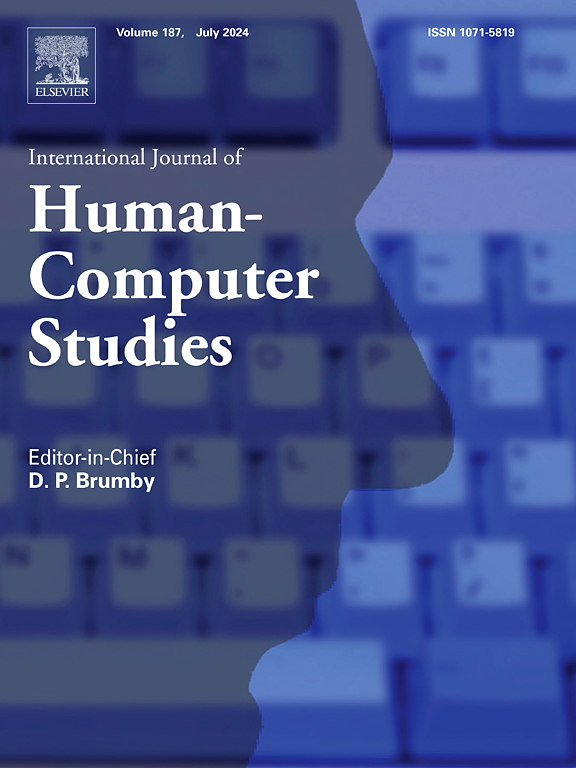Multi-semantic and multi-behavior recommendation with graph attention networks
IF 5.3
2区 计算机科学
Q1 COMPUTER SCIENCE, CYBERNETICS
International Journal of Human-Computer Studies
Pub Date : 2025-04-08
DOI:10.1016/j.ijhcs.2025.103513
引用次数: 0
Abstract
Recommender systems have become an essential tool to help resolve the information overload problem in recent years. Traditional recommender systems usually rely on Collaborative Filtering (CF) methods based on user-item interactions. However, these methods face data sparsity issues in most cases, which negatively impact recommendation performance and reduce user experience. Recent researches focus on content enriched methods incorporating semantic relevance enhancing the representation learning and improving data utilization. To this end, this paper proposes a recommendation model, named MSMB-GAN (Multi-Semantic Multi-Behavioral Graph Attention Network) aimed at improving recommendation accuracy. To construct this model, multi-facet information is made full use, including user-item interaction behavior (like view, click, add to cart, etc.), social network, and item category information. An encoder is used to capture different behavior relationship between users and items; and a graph attention mechanism is used to capture the strength of user-user social relationship; and a decay factor is introduced to represent the changing demand of users to different item categories in this model. Finally, the user representations extracted from the user-item interaction behaviors, user-user social relationships, and item-category correspondence information are weighted and integrated. Experimental results on synthetic and real-world datasets show that MSMB-GAN can achieve better recommendation performance compared to some existing methods. Further ablation experiments verify the effectiveness of utilizing multi-source information.
基于图注意网络的多语义多行为推荐
近年来,推荐系统已成为解决信息过载问题的重要工具。传统的推荐系统通常依赖于基于用户-物品交互的协同过滤(CF)方法。然而,这些方法在大多数情况下都面临数据稀疏性问题,这会对推荐性能产生负面影响,降低用户体验。近年来的研究主要集中在内容丰富的方法,包括语义关联、表示学习和提高数据利用率。为此,本文提出了一种旨在提高推荐准确率的推荐模型MSMB-GAN (Multi-Semantic Multi-Behavioral Graph Attention Network,多语义多行为图注意网络)。在构建该模型时,充分利用了多方面的信息,包括用户与商品的交互行为(如查看、点击、加入购物车等)、社交网络、商品类别信息。编码器用于捕捉用户与物品之间的不同行为关系;利用图注意机制捕捉用户-用户社会关系的强弱;在模型中引入衰减因子来表示用户对不同商品类别需求的变化。最后,对从用户-物品交互行为、用户-用户社会关系和物品-类别对应信息中提取的用户表示进行加权和整合。在合成数据集和真实数据集上的实验结果表明,与现有的一些方法相比,MSMB-GAN可以获得更好的推荐性能。进一步的烧蚀实验验证了多源信息利用的有效性。
本文章由计算机程序翻译,如有差异,请以英文原文为准。
求助全文
约1分钟内获得全文
求助全文
来源期刊

International Journal of Human-Computer Studies
工程技术-计算机:控制论
CiteScore
11.50
自引率
5.60%
发文量
108
审稿时长
3 months
期刊介绍:
The International Journal of Human-Computer Studies publishes original research over the whole spectrum of work relevant to the theory and practice of innovative interactive systems. The journal is inherently interdisciplinary, covering research in computing, artificial intelligence, psychology, linguistics, communication, design, engineering, and social organization, which is relevant to the design, analysis, evaluation and application of innovative interactive systems. Papers at the boundaries of these disciplines are especially welcome, as it is our view that interdisciplinary approaches are needed for producing theoretical insights in this complex area and for effective deployment of innovative technologies in concrete user communities.
Research areas relevant to the journal include, but are not limited to:
• Innovative interaction techniques
• Multimodal interaction
• Speech interaction
• Graphic interaction
• Natural language interaction
• Interaction in mobile and embedded systems
• Interface design and evaluation methodologies
• Design and evaluation of innovative interactive systems
• User interface prototyping and management systems
• Ubiquitous computing
• Wearable computers
• Pervasive computing
• Affective computing
• Empirical studies of user behaviour
• Empirical studies of programming and software engineering
• Computer supported cooperative work
• Computer mediated communication
• Virtual reality
• Mixed and augmented Reality
• Intelligent user interfaces
• Presence
...
 求助内容:
求助内容: 应助结果提醒方式:
应助结果提醒方式:


